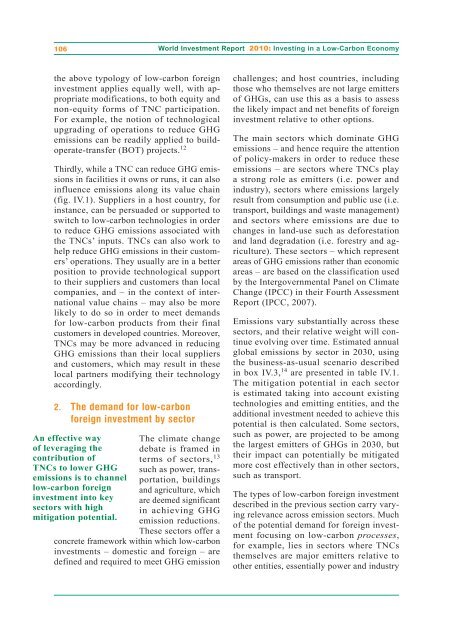UN World Investment Report 2010 - Office of Trade Negotiations
UN World Investment Report 2010 - Office of Trade Negotiations
UN World Investment Report 2010 - Office of Trade Negotiations
Create successful ePaper yourself
Turn your PDF publications into a flip-book with our unique Google optimized e-Paper software.
106<br />
the above typology <strong>of</strong> low-carbon foreign<br />
investment applies equally well, with appropriate<br />
modifications, to both equity and<br />
non-equity forms <strong>of</strong> TNC participation.<br />
For example, the notion <strong>of</strong> technological<br />
upgrading <strong>of</strong> operations to reduce GHG<br />
emissions can be readily applied to buildoperate-transfer<br />
(BOT) projects. 12<br />
Thirdly, while a TNC can reduce GHG emissions<br />
in facilities it owns or runs, it can also<br />
influence emissions along its value chain<br />
(fig. IV.1). Suppliers in a host country, for<br />
instance, can be persuaded or supported to<br />
switch to low-carbon technologies in order<br />
to reduce GHG emissions associated with<br />
the TNCs’ inputs. TNCs can also work to<br />
help reduce GHG emissions in their customers’<br />
operations. They usually are in a better<br />
position to provide technological support<br />
to their suppliers and customers than local<br />
companies, and – in the context <strong>of</strong> international<br />
value chains – may also be more<br />
likely to do so in order to meet demands<br />
for low-carbon products from their final<br />
customers in developed countries. Moreover,<br />
TNCs may be more advanced in reducing<br />
GHG emissions than their local suppliers<br />
and customers, which may result in these<br />
local partners modifying their technology<br />
accordingly.<br />
2. The demand for low-carbon<br />
foreign investment by sector<br />
The climate change<br />
debate is framed in<br />
terms <strong>of</strong> sectors, 13<br />
An effective way<br />
<strong>of</strong> leveraging the<br />
contribution <strong>of</strong><br />
TNCs to lower GHG such as power, trans-<br />
emissions is to channel portation, buildings<br />
low-carbon foreign and agriculture, which<br />
investment into key are deemed significant<br />
sectors with high in achieving GHG<br />
mitigation potential.<br />
emission reductions.<br />
These sectors <strong>of</strong>fer a<br />
concrete framework within which low-carbon<br />
investments – domestic and foreign – are<br />
defined and required to meet GHG emission<br />
<strong>World</strong> <strong>Investment</strong> <strong>Report</strong> <strong>2010</strong>: Investing in a Low-Carbon Economy<br />
challenges; and host countries, including<br />
those who themselves are not large emitters<br />
<strong>of</strong> GHGs, can use this as a basis to assess<br />
the likely impact and net benefits <strong>of</strong> foreign<br />
investment relative to other options.<br />
The main sectors which dominate GHG<br />
emissions – and hence require the attention<br />
<strong>of</strong> policy-makers in order to reduce these<br />
emissions – are sectors where TNCs play<br />
a strong role as emitters (i.e. power and<br />
industry), sectors where emissions largely<br />
result from consumption and public use (i.e.<br />
transport, buildings and waste management)<br />
and sectors where emissions are due to<br />
changes in land-use such as deforestation<br />
and land degradation (i.e. forestry and agriculture).<br />
These sectors – which represent<br />
areas <strong>of</strong> GHG emissions rather than economic<br />
areas – are based on the classification used<br />
by the Intergovernmental Panel on Climate<br />
Change (IPCC) in their Fourth Assessment<br />
<strong>Report</strong> (IPCC, 2007).<br />
Emissions vary substantially across these<br />
sectors, and their relative weight will continue<br />
evolving over time. Estimated annual<br />
global emissions by sector in 2030, using<br />
the business-as-usual scenario described<br />
in box IV.3, 14 are presented in table IV.1.<br />
The mitigation potential in each sector<br />
is estimated taking into account existing<br />
technologies and emitting entities, and the<br />
additional investment needed to achieve this<br />
potential is then calculated. Some sectors,<br />
such as power, are projected to be among<br />
the largest emitters <strong>of</strong> GHGs in 2030, but<br />
their impact can potentially be mitigated<br />
more cost effectively than in other sectors,<br />
such as transport.<br />
The types <strong>of</strong> low-carbon foreign investment<br />
described in the previous section carry varying<br />
relevance across emission sectors. Much<br />
<strong>of</strong> the potential demand for foreign investment<br />
focusing on low-carbon processes,<br />
for example, lies in sectors where TNCs<br />
themselves are major emitters relative to<br />
other entities, essentially power and industry

















